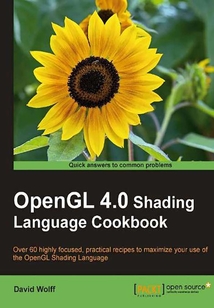舉報 

會員
OpenGL 4.0 Shading Language Cookbook
最新章節:
Index
Thishands-onguidecutsshortthepreambleandgetsstraighttothepoint–actuallycreatinggraphics,insteadofjusttheoreticallearning.Eachrecipeisspecificallytailoredtosatisfyyourappetiteforproducingreal-time3-DgraphicsusingGLSL4.0.IfyouareanOpenGLprogrammerlookingtousethemodernfeaturesofGLSL4.0tocreatereal-time,three-dimensionalgraphics,thenthisbookisforyou.FamiliaritywithOpenGLprogramming,alongwiththetypical3Dcoordinatesystems,projections,andtransformationsisassumed.ItcanalsobeusefulforexperiencedGLSLprogrammerswhoarelookingtoimplementthetechniquesthatarepresentedhere.
目錄(97章)
倒序
- 封面
- 版權信息
- Credits
- About the Author
- About the Reviewers
- www.PacktPub.com
- Support files eBooks discount offers and more
- Preface
- What this book covers
- What you need for this book
- Who this book is for
- Conventions
- Reader feedback
- Customer support
- Chapter 1. Getting Started with GLSL 4.0
- Introduction
- Using the GLEW Library to access the latest OpenGL functionality
- Using the GLM library for mathematics
- Determining the GLSL and OpenGL version
- Compiling a shader
- Linking a shader program
- Sending data to a shader using per-vertex attributes and vertex buffer objects
- Getting a list of active vertex input attributes and indices
- Sending data to a shader using uniform variables
- Getting a list of active uniform variables
- Using uniform blocks and uniform buffer objects
- Building a C++ shader program class
- Chapter 2. The Basics of GLSL Shaders
- Introduction
- Implementing diffuse per-vertex shading with a single point light source
- Implementing per-vertex ambient diffuse and specular (ADS) shading
- Using functions in shaders
- Implementing two-sided shading
- Implementing flat shading
- Using subroutines to select shader functionality
- Discarding fragments to create a perforated look
- Chapter 3. Lighting Shading Effects and Optimizations
- Introduction
- Shading with multiple positional lights
- Shading with a directional light source
- Using per-fragment shading for improved realism
- Using the halfway vector for improved performance
- Simulating a spotlight
- Creating a cartoon shading effect
- Simulating fog
- Chapter 4. Using Textures
- Introduction
- Applying a 2D texture
- Applying multiple textures
- Using alpha maps to discard pixels
- Using normal maps
- Simulating reflection with cube maps
- Simulating refraction with cube maps
- Image-based lighting
- Applying a projected texture
- Rendering to a texture
- Chapter 5. Image Processing and Screen Space Techniques
- Introduction
- Applying an edge detection filter
- Applying a Gaussian blur filter
- Creating a "bloom" effect
- Using gamma correction to improve image quality
- Using multisample anti-aliasing
- Using deferred shading
- Chapter 6. Using Geometry and Tessellation Shaders
- Introduction
- Point sprites with the geometry shader
- Drawing a wireframe on top of a shaded mesh
- Drawing silhouette lines using the geometry shader
- Tessellating a curve
- Tessellating a 2D quad
- Tessellating a 3D surface
- Tessellating based on depth
- Chapter 7. Shadows
- Introduction
- Rendering shadows with shadow maps
- Anti-aliasing shadow edges with PCF
- Creating soft shadow edges with random sampling
- Improving realism with prebaked ambient occlusion
- Chapter 8. Using Noise in Shaders
- Introduction
- Creating a noise texture using libnoise
- Creating a seamless noise texture
- Creating a cloud-like effect
- Creating a wood grain effect
- Creating a disintegration effect
- Creating a paint-spatter effect
- Creating a night-vision effect
- Chapter 9. Animation and Particles
- Introduction
- Animating a surface with vertex displacement
- Creating a particle fountain
- Creating a particle system using transform feedback
- Creating a particle system using instanced particles
- Simulating fire with particles
- Simulating smoke with particles
- Index 更新時間:2021-04-02 18:59:55
推薦閱讀
- Adobe創意大學After Effects CS5 產品專家認證標準教材
- Spring Python 1.1
- AI繪畫教程:Midjourney關鍵詞靈感手冊
- FreeSWITCH 1.0.6
- Photoshop CS6中文版基礎培訓教程
- Adobe創意大學After Effects產品專家認證標準教材(CS6修訂版)
- Drupal: Creating Blogs, Forums, Portals, and Community Websites
- AutoCAD 2014實用教程(第4版)
- UG NX 8.0模具設計教程
- 精進PPT:PPT設計思維、技術與實踐(第3版)
- 音樂日記:Studio One 6場景×風格編曲實用教程
- Photoshop+CorelDRAW 字體設計與創意:草圖/實現/包裝(微課版)
- 零基礎攝影后期修圖 Photoshop照片處理輕松入門
- Origin 2022科學繪圖與數據分析(高級應用篇)
- After Effects 影視后期特效:短視頻制作實戰寶典
- 剪映:零基礎輕松掌握手機剪輯短視頻
- Photoshop CC圖形圖像處理實戰教程(微課版)
- Adobe創意大學視頻編輯師 After Effects CS5 + Premiere Pro CS5 標準實訓教材
- Creo 6.0產品設計實例精解
- 從小白到高手:Studio One快速上手教程
- CorelDRAW X7中文版基礎教程
- Tilcon圖形界面設計基礎
- AutoCAD 2022中文版標準教程
- Autodesk Inventor中文版從入門到精通(2020版)
- Oracle APEX 4.0 Cookbook
- MG動畫實戰從入門到精通(視頻微課版)
- 物品編碼標識
- SEO搜索引擎優化:原理+方法+實戰
- 中望3D產品設計實用教程
- iPad數字繪畫創作全攻

